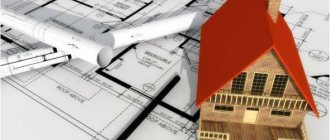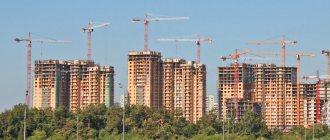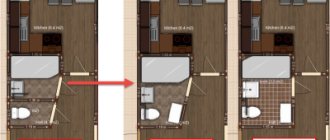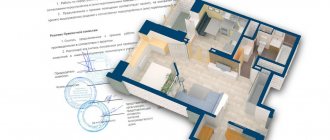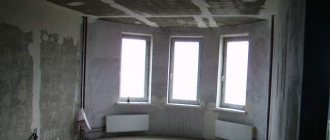Open plan
Legally, there is no such thing as an open plan. This term is used by developers of new buildings as a marketing ploy. But if we turn to the floor plan of the house, we will see that the walls that have already been erected are marked with black bright lines, and those that have not been erected, but should be, are marked with dotted lines and, accordingly, the responsibility for their construction falls on the owner.
Now imagine the situation : you buy an apartment “without partitions”, plan the placement of rooms, etc., carry out renovations and it turns out that the developer received permission for a completely different apartment project, and your layout is illegal.
Only they “forgot” to warn you about the approved project.
Even in new buildings there are no “open layouts”
Buyers of apartments on the primary market in monolithic brick buildings are often misled by the phrase about “free layout,” while the same restrictions apply to the layout of such apartments as on the secondary market. As a result, many apartments with illegal redevelopment in former new buildings end up on the market. Experts wrote about what cannot be changed in your own apartment in the article “Redevelopment can kill and deprive you of your home.” This time we will talk about how to sell and buy a home with uncoordinated redevelopment.
The myth of free planning The term “free planning” refers to the minimum number of load-bearing walls (columns), as well as the absence of interior partitions. Meanwhile, legally there is no such thing as “free planning”, says Natalya Abramova, General Director (part of the INTECO Group of Companies).
As a rule, even in apartments that are sold with an open plan, there is a design plan, which is included in booklets and other information sources about the residential complex. “This layout takes into account insolation standards, thermal characteristics, and sound insulation qualities of the apartment,” says Grigory Altukhov, commercial director of FSK Leader. If the owner of the apartment equips it according to this plan, then no additional planning approvals are required.
True, as Natalya Abramova notes, the plan in the booklet is still approximate, and the only valid document that determines the layout of the apartment is the BTI plan. Usually these plans are identical, but sometimes there are overlaps. For example, private realtor Viktor Kupriyanov helped sell an apartment to a client who was its first owner, and the apartment was furnished by the developer. “And only when we took the plan from the BTI for the appraiser, an interesting fact emerged: the bathroom with the “dark room” were confused with each other. It’s hard to say whose mistake it was – those who did the repairs, or those who drew the plan,” he says. The transaction ended normally, but VTB 24 bank took a statement from the buyer that he would approve the redevelopment or make the apartment comply with the BTI plan.
If the owner decides to plan an apartment in a new building in his own way, then he will have to coordinate the redevelopment. “He must privately invite a designer who will develop a detailed layout design for him. With this project, you must first contact the operating organization, and then the housing inspection of Moscow or the Moscow region,” says Grigory Altukhov. If the project is approved and a positive result is obtained, the head of the government issues a resolution to make changes to the layout of this particular apartment.
In the case of new buildings, the same restrictions apply as for secondary apartments: it is forbidden to demolish load-bearing structures, it is mandatory to have a window in the room, you cannot place wet areas above the living rooms of neighbors, and so on (for more information about these restrictions, read the article “Redevelopment can kill and deprived of housing").
Typically, developers do not provide assistance to buyers with individual planning. “Unfortunately, such services today are often provided by the “gray market” and companies that have nothing to do with the developer,” says Natalya Abramova. However, large developers are increasingly creating a separate division or company that deals with redevelopment. For example, in the INTECO Group of Companies this is done by Magistrat-Art, and in the FSK Leader - .
Legal issue Subsequently, when the owners of apartments in new buildings, who did not bother to coordinate the layout, put them up for resale, this issue will still arise. Often they are unaware that they should have agreed on something. Private realtor Viktor Kupriyanov recalls an apartment in Reutov in which a built-in wardrobe was eliminated: “The owners owned the apartment for more than 10 years and did not know that this was a redevelopment. We learned from a BTI specialist when we were preparing for a mortgage transaction.”
According to the Yakovlev and Partners legal group, of all redevelopments and reconstructions carried out, no more than 5% are approved. “Given the attention that buyers pay to the apartments they are purchasing, the share of legal redevelopments among the apartments being sold is probably higher,” suggests company specialist Alexander Machnev, lawyer in the Land, Real Estate, Construction practice. Realtors say that, “by eye,” approximately every tenth apartment on the secondary market has an illegal redevelopment.
It is believed that selling an apartment with uncoordinated redevelopment is much more difficult. However, according to realtors, people sometimes overestimate this problem. In most cases, it is possible to sell such housing, at least there are no legal obstacles. “During the purchase and sale, the issue of the right to real estate is resolved, and the non-legal fate of technical parameters is not affected,” says Alexander Manchev.
That is, illegal redevelopment itself is not a contraindication for sale. However, the new owner, according to the Housing Code, is obliged to either bring the housing into proper condition in accordance with the current floor plan, or legalize this redevelopment within 6 months. To do this, you need to go to the arbitration court and prove that the completed redevelopment does not violate the rights and legitimate interests of citizens and does not create a threat to their life or health, says lawyer Ekaterina Baglaeva. Such evidence could be, for example, a construction and technical examination report. “An apartment in which a redevelopment has been made that cannot be legalized will most likely take a very long time to find a new owner,” says Irina Shugurova, deputy managing director for legal issues at MIEL-Network of Real Estate Offices.
Discount for imagination Most often, apartments with uncoordinated redevelopment are offered at a lower price, but there is no universal discount size. “When the costs of legalization are insignificant, buyers do not focus on unauthorized redevelopment. If the process costs the buyer a pretty penny, the parties try to reach a consensus through negotiations, notes Elena Bobkova, head of the Green Prospekt office. – Usually the cost of legalization is simply deducted from the price of the apartment, since the new owner takes full responsibility for the apartment. Thus, the sale of an apartment with redevelopment, which cannot be legalized, becomes unpredictable. So, the seller may or may not lose around 25% of the market value of the property, it all depends on the level of demand for a particular property.”
According to the general director (part of the NDV Group of Companies) Boris Leontyev, sometimes the discount can even be several times higher than the costs associated with legalizing the layout. After all, the buyer faces not only additional costs, but also loss of time and unnecessary bureaucracy.
Meanwhile, the cost of an apartment does not always fall due to redevelopment. “If the redevelopment is very successful, the price may rise, since the property immediately stands out from the general mass of standard housing,” says Anna Moiseeva, managing director of AN Home Staging. For example, once Anna was selling a two-room apartment in a Khrushchev-era building with adjacent rooms, which was successfully converted into a small three-room apartment. “It is impossible to coordinate such a redevelopment (one room turned out to be without a window, the kitchen with a gas stove was combined with part of the room, which is also prohibited), but the buyers liked the layout and paid 10% higher than the market price of such two-room apartments,” recalls the realtor.
In some cases, realtors even recommend that clients purchase an apartment with illegal remodeling because of the discount. One of Viktor Kupriyanov’s clients liked an apartment on Rogozhsky Val Street with a part of the outer wall removed - a door was made from the window, and a dishwasher and gas stove were installed on the loggia. Such redevelopment can only be restored; it cannot be legitimized. However, the realtor did not object to the purchase of this apartment. The fact is that it was not a panel house, and the outer wall was made of expanded clay blocks and did not carry a load - that is, there was no danger of destruction. In addition, the buyer was already planning a complete renovation of the apartment, so in the overall budget the cost of returning to its original appearance was insignificant.
Mortgage problems A really big obstacle to redevelopment can be for buyers who need a mortgage. For example, PR manager Anna Chukseyeva was looking for an apartment last fall, and among the many interesting and attractively priced options, there were mostly apartments with illegal redevelopment. “Not all banks were ready to provide mortgages for redevelopment options. So the sellers were looking for potential buyers willing to make a cash transaction, she says. “Then I found an attractive option for myself without any visible redevelopment - all the walls were in place. It turned out that this apartment had also been remodeled: the door to the kitchen was removed and the closet doors were dismantled. As a result, neither I nor the sellers decided not to take risks with the bank and part ways.”
Banks never issue a loan for an apartment with redevelopment, the approval of which is in principle impossible. But many of them are ready to provide a mortgage if the redevelopment can be legalized and the buyer undertakes to do this within a certain time. “The client provides a notarized undertaking that within six months from the date of the transaction he is obliged to either legalize the redevelopment or return the property to its original state in accordance with the BTI plan,” says Maxim Chestikin, head of the mortgage lending department at SB Bank. When analyzing the collateral object, the bank is guided by the report of independent appraisal companies, which specifically indicates whether this or that redevelopment is subject to approval.
True, sometimes sellers and buyers manage to “deceive” appraisers. Some of them create temporary “appearances”: they erect false walls in place of demolished ones, put the battery in the right place, although all the radiators have long been moved, etc. And a client of realtor Viktor Kupriyanov somehow managed to negotiate with the appraiser to photograph the rooms from such an angle so that the illegal redevelopment would not be noticeable. As the realtor says, the appraiser did not take any additional “bribe” for such a concession.
Thus, illegal redevelopment may interfere with the sale of the apartment. However, according to experts, it will most likely complicate life not for the seller, but for the buyer, both in the secondary and primary markets.
Current projects of the FSK company (September 2020)
TableMap
| Project | Location | GK | Price per apartment |
| Skolkovsky | Odintsovo district, Odintsovo | 4 sq. 2021 | from 4,984,408 rub. |
| Richard | Moscow, Northern District, Khoroshevsky district, Polezhaevskaya metro station | 1 sq. 2022 | from 8,964,630 rub. |
| Movement. Tushino | Moscow, Northwestern District, Pokrovskoye-Streshnevo district, Tushinskaya metro station | 2 sq. 2022 | from RUB 5,829,786 |
| Roman | Leninsky district, Razvilka village | 2 sq. 2020 | from 5,254,200 rub. |
| microdistrict Center-2 | Zheleznodorozhny | was passed | from 3,446,685 rub. |
| Breath | Moscow, Northern District, Timiryazevsky district, Timiryazevskaya metro station | 4 sq. 2020 | from 18,622,473 rub. |
| Mood | Moscow, North-Eastern district, Yaroslavsky district, metro station Rostokino MCC | 3 sq. 2021 | from 7,432,750 rub. |
| Novogireevsky | Balashikha district, Balashikha | was passed | from 8,706,100 rub. |
| Danish quarter | Mytishchi district, Mytishchi | 2 sq. 2022 | from 4,114,570 rub. |
Data source: Real estate database IRN.RU
show all
Do's and don'ts
Even if there are no walls in the apartment, when planning the layout of the premises it is worth remembering a few rules:
What not to do:
- move the bathroom and kitchen, as these are wet areas;
- move ventilation and gas pipes;
- make the premises non-residential without obtaining permission;
- erect structures that will impede access to utilities;
- install heated floors from hot water supply or from the heating system (if it is an apartment), etc.
What you can do:
- combine a bathroom and a toilet or expand them at the expense of the corridor (while arranging waterproofing of the floor and making thresholds);
- expand the corridor at the expense of the living room (remember the minimum size of living space per person), etc.
How to legalize redevelopment in a new building with an open plan
Often redevelopment in an open-plan apartment is carried out illegally by the owners. This is when repair work is carried out without any approval.
It is possible to legalize the redevelopment of an open-plan apartment in a new building if all the work carried out complies with generally accepted building codes. Otherwise, the Moscow Housing Inspectorate will oblige you to redo the repairs.
In addition, you will have to pay a fine . If the owner did not violate anything during the repair, then he can legitimize the completed reconstruction by providing the Moscow Housing Inspectorate with a technical report on the admissibility and safety of the work performed.
Read more: If the contract is extended, is an additional agreement necessary?
Be that as it may, before you begin to coordinate the future redevelopment of an open-plan apartment or to legitimize work already completed, first obtain advice from specialists in the field of design and design of redevelopments.
Our company provides free consultations. You can address your questions to our consultants by phone or online .
At your request, we can prepare a project with a technical report for future redevelopment or a technical report on the fact of completed work, if the redevelopment has already been done.
You can use it with us. In this case, the preparation of all documents and interaction with government agencies (BTI and the Moscow Housing Inspectorate) will be handled not by you, but by us, by proxy .
Examples of redevelopment of “open plan” apartments:
We understand the issue of housing layout and find out whether the absence of walls in a new apartment is so attractive.
How to obtain permission for redevelopment
- We prepare the project together with an organization that has received membership in the SRO and coordinate it with all services, for example, the fire inspectorate, SES, etc.
- We contact the local self-government body, which issues permission for redevelopment with the following documents:
- Passport;
- Statement;
- Project;
- Consent of neighbors;
- Technical passport and title documents (optional).
- We receive permission or refusal (you can appeal within 3 months in court).
- Based on the project, we carry out repair work.
- We call a specialist from the authority that issued the permit and receive an acceptance certificate for the work performed. If the final result differs from the project, no one will accept the work, since they approved and gave permission for what is indicated in the project. Therefore, the owner must return the premises to the condition provided for by the project.
- The act is sent by the body to Rosreestr and changes are made to the Unified State Register.
Features: each region has its own procedure for obtaining permission for redevelopment.
For example, in Moscow, a design option based on a standard project is possible. This option will save the owner money and time, and at the same time protect him from unnecessary problems, allowing him to obtain permission. Therefore, we recommend that before starting redevelopment, you contact the local self-government body to find out the procedure and rules for processing documents.
The meaning of the word planning
All the main points regarding this process will be discussed in detail in the chapter “Redevelopment”.) If you are completely satisfied with the arrangement of the rooms in your house, as well as its general layout, then you will not have to include the removal or demolition of walls in the estimate.
Anna really liked the apartment; she had never seen such a layout for a two-room apartment: the house is old, that’s why the layout is so original and there are so many utility rooms, Anna explained to herself then.
But the problems with low-rise cottage design, the lack of qualified architects, the creation of projects through acquaintances (most often, design documentation was ordered from familiar architects in cash, and for the most part served only as an unsubscribe for obtaining permission for development), construction teams of covens, etc. - all this led to the fact that in houses of this period the layout is often close to the layout of a city apartment (small rooms), the foundation may not meet the requirements of the soil (for example, it is located above the freezing point of the soil on heaving soils and with a fairly significant weight of the house), the walls are damp ( violation of construction technologies), there is rot in the under-roof space (roofers forgot about ventilation), etc.
Even though Angus had been here before, he couldn't help but feel triumphant at the thought that this magical home, with breathtaking views and a layout that made the most of natural light, was his.
The occupiers moved most of the local residents here from their rural homes and forced them to build similar dwellings for themselves; and the fact that the layout and materials used in the event of a fire turned the houses into a real trap was explained not only by the oversight of the architects.
It is clear that this layout is closely related to the more general problem of orientation, which played an extremely important role in all traditional civilizations of antiquity, whether it concerned the city as a whole or individual buildings.
The unusual layout blurred the usual outlines of the streets; the houses stood freely, arranged in wide rings.
Internal layout of the garage: 1 - washbasin; 2 - cabinet with drawers; 3, 11 — boards for Tools; 4 - workbench;
Needless to say, a flat, dull area, built up mainly with wooden houses, which in general do not even pretend to architectural beauty, an irregular layout, in which there is nothing picturesque or original, a long and sleepy street lazily stretching across the entire peninsula, one end abutting the city a prison and a hill with a gallows, and others to an almshouse - in a word, the whole appearance of the city where I was born can inspire no more tender feelings than a board with randomly scattered checkers.
Is redevelopment of an apartment in a new building allowed?
Changing the layout of an apartment is allowed both in a secondary residential premises and in a new building, and it is much easier to do this before the house is put into operation than after, since while the house has not yet been put into operation, construction and repair work is underway in it and the necessary adjustments can be made to This stage is easiest. Redevelopment of residential premises in a new building must be agreed upon with the chief architect of the project of the house under construction and all competent government authorities.
Redevelopment before obtaining ownership rights
Until recently, according to Russian legislation, redevelopment was allowed only in the apartment in a new building for which ownership rights were registered. But then the government made certain amendments and changes to legislative and regulatory acts, and now reconstruction is possible even before putting the house into operation and receiving an extract from the Unified State Register of Ownership of the property.
As in any other case, the redevelopment of an apartment in a building that has not yet been commissioned must be approved. To coordinate this issue, title documents for residential premises are required, which the owners of a new apartment cannot have in principle, therefore the document establishing the rights to the property, in this case, is an equity participation agreement (DPA) or an assignment agreement if the apartment was purchased on the assignment of rights of claim. In addition to this agreement between the developer and the participant in shared construction, it is necessary to collect the following documents:
- written consent of the developer, issued after agreeing on the redevelopment with the chief architect of the new building project;
- a copy of the permit to put an apartment building into operation;
- act of acceptance and transfer of residential premises from the developer to the new owner (original or copy);
- documentary evidence of full mutual settlements with the developer (checks, receipts, certificates of absence of debt, etc.).
In the case where redevelopment is planned in a new building before receiving ownership of the housing, and the developer has already commissioned the house under the acceptance certificate, in order to approve the redevelopment, it is also necessary to provide a conclusion on the commissioning of the house.
If a citizen planning to carry out redevelopment in a new apartment owned by the municipality, and who lives in it on the basis of a social tenancy agreement, wants to coordinate this issue and obtain official permission to bring the idea to life, he will be required to:
- a copy of the order of the head of the local administration on construction;
- act of acceptance and transfer of a new building;
- a social tenancy agreement, on the basis of which a person lives or plans to live in the near future in a given residential premises.
Redevelopment with open plan
Free planning is a phrase that attracts the attention of potential buyers of residential real estate in a new building, makes a good “screaming” advertisement for the developer and hides the developer’s quite successful attempts to save money on building a house. Free planning means the absence of non-load-bearing partitions in the apartment or the conditional delimitation of functional zones in the room by erecting a small “border” one brick high. This supposedly gives future owners the opportunity to build their own cozy nest with the layout they themselves want. But it's not that simple.
The developer, according to the project and plan of the house, which he executively provides to state regulatory authorities, shows these “curbs” as full-fledged walls and partitions, fully built in accordance with regulatory requirements. In fact, instead of walls and partitions separating the toilet, bathroom, kitchen, corridor and bedroom, the apartment simply does not exist. They exist, but only on paper, but in fact the construction company simply saved money by presenting all this as if it cares about the comfort and convenience of future residents.

